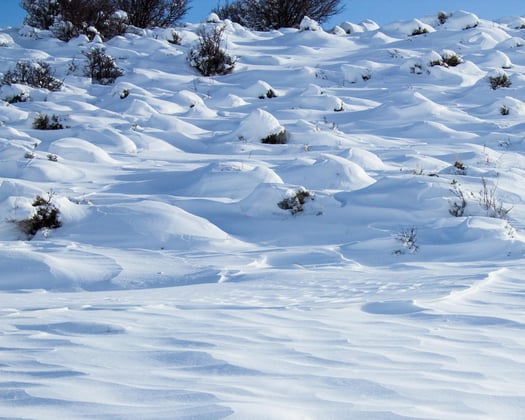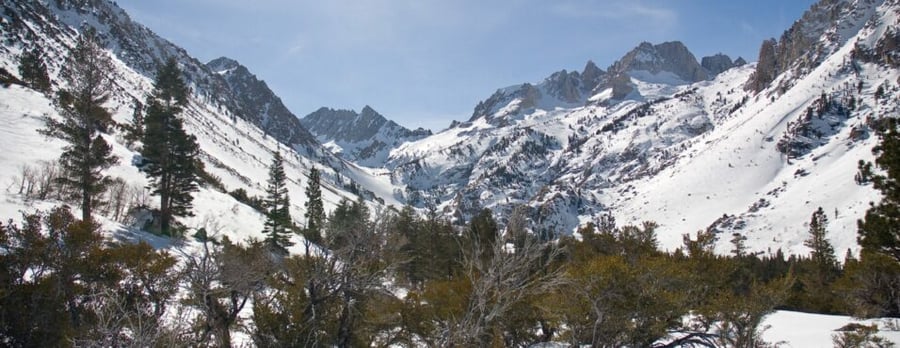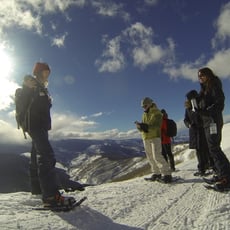Caminatas en Raquetas de Nieve - Su Historia y Importancia
Está llegando al punto en la temporada de esquí en el que el vert comienza a acumularse y el sol...



Cuando se vive en las Montañas Rocosas en invierno es imposible no interactuar con la nieve. La nieve facilita todo tipo de recreación invernal. La nieve dificulta la conducción por las carreteras. La nieve proporciona una munición excelente para las peleas de bolas de nieve y la lucha en la nieve. La nieve es un medio creativo maravilloso para dibujos, esculturas y muñecos de nieve. A algunas personas realmente no les gusta la nieve, ¡pero a otras les encanta! Dado que todos vivimos en un entorno de invierno nevado, exploremos por qué la nieve es importante.
La nieve comienza en nuestra atmósfera como vapor de agua que se cristaliza en una partícula en el aire (como polvo, humo o bacterias) cuando las temperaturas descienden por debajo del punto de congelación, 32 ° F. Dependiendo de la cantidad de humedad y las temperaturas en el ambiente, cada el cristal de nieve se forma de manera diferente. Por lo general, buscamos copos de nieve con seis brazos en forma de rama llamados dendritas estelares, pero los copos de nieve pueden tener muchas formas y tamaños diferentes. A medida que la nieve se acumula en el suelo, forma capas dentro de la capa de nieve desde la más antigua en la parte inferior hasta la más nueva en la parte superior. Con el tiempo, los cristales de nieve cambian de tamaño y forma en pequeñas bolas circulares de hielo llamadas rondas que a menudo se unen dentro de una capa de nieve. Para leer las historias que registra la nieve, la gente cava pozos de nieve en la capa de nieve para exponer las capas de nieve y observar el tamaño y la forma de los cristales de nieve en cada capa.
La capa de nieve es un gran lienzo para contar las historias de qué animales han visitado un lugar. Así como dejamos huellas al caminar en la nieve, también lo hacen los ciervos, zorros, carboneros, urracas y muchos otros animales. A veces hay pistas en las huellas de un encuentro entre depredador y presa o simplemente una señal de que un animal se detuvo para oler algo. El espacio debajo de la capa de nieve también está lleno de vida en invierno. La capa inferior de la capa de nieve se calienta con el calor de la tierra y, en lugar de formar una capa de rondas, los cristales de nieve se vuelven más grandes, angulares y parecidos al azúcar, pero no se pegan muy bien.
En esta capa situada bajo la nieve, los animales como ratones, topillos, tuzas de bolsillo e insectos pueden permanecer activos todo el invierno y buscan comida o cazan bajo la cálida manta de nieve. Estos animales pueden moverse fácilmente debajo de la nieve y hacer túneles entre los cristales de nieve débilmente conectados. Para estos animales, la capa de nieve les brinda refugio y protección contra algunos depredadores. Dado que hay una gran cantidad de aire entre los cristales de nieve, el cuerpo de un animal puede calentar el aire a su alrededor y crear una capa de aislamiento, como si usaras un abrigo de plumón en invierno. Sin embargo, los túneles bajo la nieve no pueden proteger a los animales de todos los depredadores. El cuerpo largo y estrecho de la comadreja le permite moverse a través de túneles de nieve mientras caza presas. La nieve también proporciona refugio a la comadreja. Una comadreja puede crear sus propios túneles y guaridas, haciendo que la guarida sea más acogedora y cálida al revestirla con el pelaje de su presa caída. A veces, las comadrejas se aventuran por encima de la nieve, pero su pelaje de invierno blanco se mezcla con la nieve, lo que las ayuda a camuflarse de los depredadores.
Cuando llega la primavera, estos animales y nuestra comunidad humana dependen del agua de deshielo como agua potable. El deshielo llena los arroyos y ríos que alimentan al río Eagle. Las comunidades de todo el condado de Eagle utilizan el agua del río Eagle como nuestra principal fuente de agua potable. Mantener limpia la nieve y el agua del río es una forma de proteger nuestra salud y nuestro sustento. Dado que no somos los únicos que nos beneficiamos del agua en la capa de nieve invernal, debemos ser conscientes de la cantidad de agua que consumimos. Una vez derretida, parte del agua de la capa de nieve se desvía a través de acueductos hacia Front Range y gran parte del agua fluye por el río Colorado hacia los estados del suroeste y México. La vida sería mucho más difícil para quienes se encuentran fuera del Valle de Eagle sin agua de la nieve en el invierno.
Lo más importante es que la nieve es divertida. Sí, el clima invernal es frío, ventoso, húmedo y helado. Pero la nieve también brilla bajo el sol, cubre los árboles y ayuda a que el mundo que nos rodea se vea fresco y hermoso. Convierte una colina en un lugar para pasear en trineo, hacer snowboard o esquiar. La nieve convierte un campo en un lienzo en blanco para imágenes y patrones. No importa cómo se sienta personalmente acerca de la nieve, pase algún tiempo este invierno saliendo y disfrute de un día nevado.
Lara Carlson es la directora senior de programas en Walking Mountains Science Center. ¡Ven a explorar la nieve este invierno con tu familia y Walking Mountains! Los programas incluyen recorridos con raquetas de nieve con guía naturalista y programas preescolares EarthKeepers. Para obtener más información, visite www.walkingmountains.org.
When living in the Rocky Mountains in the winter it is impossible not to interact with snow. Snow facilitates all kinds of winter recreation. Snow makes it challenging to drive on the roads. Snow provides excellent ammunition for snowball fights and snow wrestling. Snow is a wonderful creative medium for drawings, sculptures, and snow people. Some people really don’t like snow, but others love it! Since we all live in a snowy winter environment let’s explore why snow is important.
Snow starts in our atmosphere as water vapor that crystalizes on a particle in the air (like dust, smoke, or bacteria) when the temperatures drop below freezing, 32° F. Depending on the amount of moisture and the temperatures in the environment, each snow crystal forms differently. Most commonly we look for snowflakes with six branch-like arms called stellar dendrites, but snowflakes can come in many different shapes and sizes. As snow accumulates on the ground, it forms layers within the snowpack from the oldest on the bottom to the newest on the top. Over time, the snow crystals change size and shape into tiny circular balls of ice called rounds which often bond together within a layer of snow. To read the stories that snow records, people dig snow pits in the snowpack to expose the layers of snow and look at the size and shape of the snow crystals in each layer.
The snowpack is a great canvas to tell the stories of what animals have visited a place. Just like how we leave tracks when walking in the snow, so do deer, fox, chickadees, magpies, and many other animals. Sometimes there are clues in the tracks of a predator-prey encounter or just a sign that an animal stopped to smell something. The space under the snowpack is also teeming with life in the wintertime. The bottom layer of the snowpack is heated by the warmth of the earth and instead of forming a layer of rounds, the snow crystals become larger, angled, and sugar-like, but don’t stick together very well.
In this subnivium layer animals like mice, voles, pocket gophers, and insects can remain active all winter and forage or hunt for food under the warm blanket of snow. These animals can easily move around under the snow and make tunnels between the loosely connected snow crystals. For these animals, the snowpack provides shelter and protection from some predators. Since there is a lot of air between the snow crystals, an animal’s body can warm the air around them and create a layer of insulation, kind of like if you wear a down coat in the wintertime. However, tunnels under the snow cannot protect animals from all predators. The weasel’s long narrow body allows it to move through snow tunnels while hunting for prey. The snow also provides shelter for the weasel. A weasel can create their own tunnels and dens, making the den extra cozy and warm by lining it with the fur of its fallen prey. Sometimes weasels will venture above the snow, but their white winter coat blends in with the snow, helping to camouflage them from predators.
When spring comes, these animals and our human community depends on snowmelt water as our drinking water. Snowmelt fills the creeks and rivers that are tributaries of the Eagle River. Water in the Eagle River is used by communities throughout Eagle County as our primary source of drinking water. Keeping the snow and river water clean is a way to protect our health and livelihood. Since we aren’t the only ones who benefit from the water in the winter snowpack, we need to be conscience of how much water we consume. Once melted, some of the snowpack water is diverted through aqueducts to the Front Range and much of the water flows down the Colorado River towards the southwestern states and Mexico. Life would be much harder for those outside the Eagle Valley without water from snow in the winter.
Most importantly, snow is fun. Yes, wintery weather is cold, windy, wet, and icy. But snow also sparkles in the sunshine, blankets the trees, and helps make the world around us look fresh and beautiful. It turns a hill into a place to go sledding, or snowboarding, or skiing. Snow turns a field into a blank canvas for pictures and patterns. No matter how you personally feel about snow, spend some time this winter getting outside and enjoy a snowy day.
Lara Carlson is the Senior Programs Director at Walking Mountains Science Center. Come explore the snow this winter with your family and Walking Mountains! Programs include Naturalist Guided Snowshoe Tours and EarthKeepers Preschool Programs. For more information visit www.walkingmountains.org.
EVOM es un grupo comunitario dirigido por Walking Mountains que ofrece una variedad de actividades al aire libre en conjunto con muchos socios de nuestra comunidad.

Está llegando al punto en la temporada de esquí en el que el vert comienza a acumularse y el sol...
